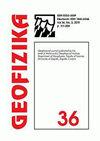Thermal perception of teenagers in a cool outdoor environment: A case study
IF 1.1
4区 地球科学
Q4 GEOCHEMISTRY & GEOPHYSICS
引用次数: 2
Abstract
Subjective thermal sensation of late teenagers was examined aiming to reveal potential discrepancies in its estimation compared to adults. Since teenagers have different clothing habits and preferences from adults, it is important to know whether the conclusions reached by studies on thermal sensation, usually involving adults, can be also applied to teenagers. A group of late teenagers was interviewed, based on a structured questionnaire, in an outdoor environment during two winter days and under an unexpected Saharan dust transport event during the second day, while meteorological measurements were obtained by the closest to the interview site weather station. Moreover, the performance of the bioclimatic index Cooling Power in simulating subjects’ thermal sensation was evaluated. Although differences in clothing thermal insulation of late teenagers compared to that suggested by similar studies were recognized, generally the results of this study were in agreement with the findings of similar field surveys focusing on individual thermal sensation and with no evidence of effects of the dust transport event on thermal sensation. Cooling Power based on the Mediterranean thermal sensation scale predicted thermal sensation vote fairly well.青少年在凉爽的室外环境中的热感知:一个案例研究
研究了青少年后期的主观热感觉,目的是揭示其估计与成人相比的潜在差异。由于青少年的穿着习惯和偏好与成年人不同,因此了解通常涉及成年人的热感觉研究得出的结论是否也适用于青少年是很重要的。根据结构化问卷,在冬季的两天和第二天的意外撒哈拉沙尘运输事件中,在室外环境中对一组晚期青少年进行了访谈,同时由离访谈地点最近的气象站获得气象测量数据。此外,还评价了生物气候指标Cooling Power在模拟受试者热感觉中的表现。虽然与类似研究相比,晚辈的服装隔热差异得到了承认,但总体而言,本研究的结果与关注个人热感觉的类似实地调查的结果一致,没有证据表明粉尘输送事件对热感觉的影响。基于地中海热感觉量表的冷功率对热感觉投票的预测效果较好。
本文章由计算机程序翻译,如有差异,请以英文原文为准。
求助全文
约1分钟内获得全文
求助全文
来源期刊

Geofizika
地学-地球化学与地球物理
CiteScore
1.60
自引率
0.00%
发文量
17
审稿时长
>12 weeks
期刊介绍:
The Geofizika journal succeeds the Papers series (Radovi), which has been published since 1923 at the Geophysical Institute in Zagreb (current the Department of Geophysics, Faculty of Science, University of Zagreb).
Geofizika publishes contributions dealing with physics of the atmosphere, the sea and the Earth''s interior.
 求助内容:
求助内容: 应助结果提醒方式:
应助结果提醒方式:


